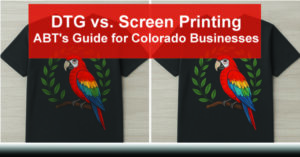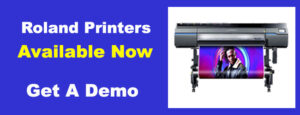What’s in This Post
In this comprehensive guide, you’ll learn:
-
The core differences between Direct-to-Garment (DTG) and screen printing
-
Pros and cons of each method for Colorado businesses
-
A detailed comparison of leading DTG and screen printing equipment, including MSRP and features
-
Real-world applications based on order volume and design complexity
-
A cost breakdown and maintenance overview for each technology
-
How ABT supports print operations with reliable toner and ink solutions
-
Expert insights to help you choose the right method—or both—for your printing needs
DTG vs. Screen Printing | A Comprehensive Guide for Colorado Businesses
If you’re business is considering custom apparel printing, understanding the differences between Direct-to-Garment (DTG) and screen printing is essential. Each printing method has unique strengths and limitations that impact production quality, scalability, and cost-effectiveness. Whether you run a small streetwear label in Denver or manage bulk apparel production in Colorado Springs, this guide will help you make an informed decision tailored to your operational needs.
Understanding DTG and Screen Printing
Direct-to-Garment (DTG) Printing
DTG is a modern printing technique that functions much like a traditional inkjet printer but designed specifically for textiles. Using specialized aqueous inks, DTG printers spray the design directly onto the garment, allowing for photorealistic and intricate prints.
Key Benefits:
- Customization Flexibility: Ideal for businesses that offer print-on-demand or limited-edition designs.
- Design Complexity: Exceptional for detailed and multi-color graphics without added cost.
- Quick Setup: Minimal setup time means faster transitions between jobs.
Challenges:
- Fabric Limitations: Best results on 100% cotton or high-cotton blends. Synthetics often require special treatment.
- Ink Cost: High cost per print, especially for color-rich designs on dark fabrics.
- Maintenance: Requires frequent cleaning and upkeep to avoid clogging and printhead issues.
Screen Printing
A time-tested technique, screen printing involves pressing ink through a stencil (screen) onto fabric. Each color in the design requires a separate screen.
Key Benefits:
- Cost Efficiency: Extremely affordable for large volume orders.
- Durability: Prints are vivid and long-lasting, with excellent wash resistance.
- Material Versatility: Effective on cotton, polyester, blends, and even non-textile materials like wood and glass.
Challenges:
- Time-Intensive Setup: Preparing screens and mixing inks increases lead time.
- Limited Intricacy: Complex, multicolor designs can be cost-prohibitive.
- Space Requirements: Screen printing setups typically require more physical space.
Brand and Equipment Comparison
Leading DTG Printers
| Brand & Model | MSRP | Features |
|---|---|---|
| Epson SureColor F2100 | $17,995 | High-resolution prints, integrated self-cleaning, included Garment Creator software |
| Ricoh Ri 2000 | $18,000+ | Rapid print cycles, advanced ink circulation, easy garment loading |
| Brother GTX Pro | $20,000+ | Bulk ink system, dual platen printing, industrial reliability |
| Roland VersaSTUDIO BT-12 | $4,995 | Compact, entry-level, perfect for startups and mobile printing setups |
Leading Screen Printing Presses
| Brand & Model | MSRP | Features |
| Riley Hopkins 150 | $1,050 | Manual press, 1-4 color stations, great for beginners |
| M&R Sportsman EX | $50,000+ | Automatic press, touchscreen interface, rapid cycle speeds |
| Anatol Volt | Contact Sales | All-electric, servo-driven indexer, energy-efficient |
| Lawson Mini-Trooper | $28,945 | Compact automatic, low maintenance, excellent for tight workspaces |
Real-World Applications
Small Batch Businesses: Local Colorado streetwear brands benefit from DTG’s flexibility, allowing them to quickly pivot designs and print short runs with minimal waste.
Bulk Custom Orders: Schools, athletic teams, and corporate clients often require large quantities with consistent quality—making screen printing the more economical and practical choice.
Mixed Operations: Some businesses run hybrid models, using DTG for sample production and small runs while shifting large orders to screen printing.
Cost Analysis & Production Efficiency
| Cost Factor | DTG | Screen Printing |
| Initial Equipment Cost | $10,000–$25,000 | $1,000–$60,000 |
| Per Print Cost | $4.50–$8.00 | As low as $1.00 |
| Setup Time | Minimal | High (screens, inks, curing time) |
| Scalability | Moderate | High |
| Labor Requirements | Low | Medium to High |
Maintenance and Troubleshooting
DTG Considerations: Regular nozzle checks, ink circulation, and proper humidity control are essential to avoid costly downtime. Most modern DTG machines come with self-cleaning features, but manual intervention is often required.
Screen Printing Care: Screens must be cleaned and stored properly to prevent warping. Regular calibration ensures registration accuracy across multiple colors.
Toner & Ink Supply with ABT
At ABT, we understand that uninterrupted workflow is crucial for your printing operations. Whether you’re running a DTG shop or managing a full-scale screen printing facility, we offer tailored toner and ink solutions that fit your needs.
Why Choose ABT:
- Comprehensive Inventory: We stock a wide range of OEM and compatible inks and toners for Epson, Brother, Ricoh, Roland, and more.
- Automated Reordering: Our systems can monitor usage and auto-replenish supplies, ensuring you’re never caught short.
- Sustainability: Eco-conscious options and recycling programs help reduce your environmental footprint.
- Technical Support: Local experts in Colorado provide guidance on everything from installation to color matching.
We go beyond simple product delivery—our team partners with you to improve operational efficiency, reduce waste, and elevate print quality.
Making the Right Choice
Consider DTG If:
- You offer frequent design updates or custom one-off prints
- Your customers demand photorealistic detail
- You’re operating in a tight space or mobile environment
Consider Screen Printing If:
- You handle high-volume orders with limited variation
- Your typical designs are bold, graphic, and color-limited
- You want the most economical print cost over time
Consider Both: Many Colorado businesses successfully operate hybrid shops to balance creative flexibility with cost-effective scalability.
Final Thoughts
Choosing between DTG and screen printing isn’t a one-size-fits-all decision. Each technology offers distinct advantages based on your business goals, customer demands, and budget. Whether you’re a startup apparel brand in Boulder or a seasoned print shop in Pueblo, the key is matching your equipment and supply chain to your specific market.
At ABT, we’re more than a vendor—we’re your partner in print innovation. From equipment recommendations to ink management and ongoing support, we’re committed to helping Colorado businesses thrive.
Ready to upgrade your print game? Reach out to ABT today.

